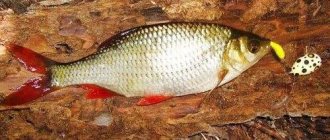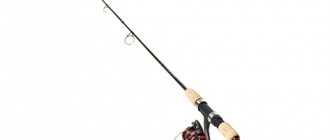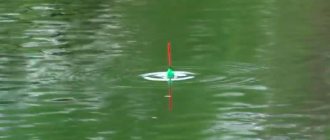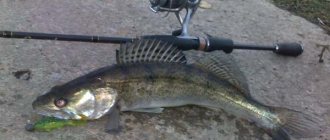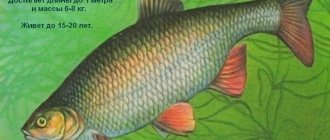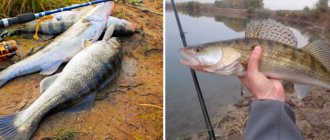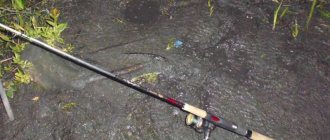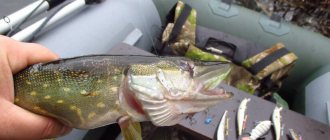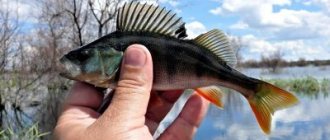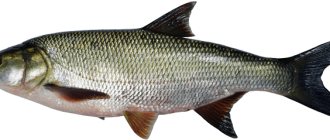The rudd is a freshwater species of fish belonging to the carp family and is very popular among fishermen. Visually it has a great resemblance to roach, so novice fishermen very often confuse them.
However, the rudd
has a number of its own individual characteristics ; it can be described as follows:
- The size of the fish is usually small; rare specimens grow more than 20-25 cm in length.
- The maximum weight of prey is within 500-700 grams.
- The head is quite small relative to the size of the body and has a triangular shape.
- The eyes are large in size, have a golden-orange color, and have a characteristic red spot.
- The mouth has a slanted shape and is noticeably directed upward; the lips have a yellowish tint. There are 16 teeth in the mouth, which grow in several rows.
- The body is quite wide, flattened on the sides, the scales are usually slightly covered with mucus.
- The color depends on the living conditions and age of a particular individual; over time, an increase in brightness is usually noticeable. In most cases, the dorsal region is green-brown in color, the belly is much lighter, and both sides have golden reflections.
- The fin located on the back resembles a fan. It is capable of opening upward, at such moments you can count about ten rays on it. The color is usually black or dark gray, but towards the top it gradually turns red.
- The fins located near the gills have a uniform gray color, but at the same time they clearly have a pink tint.
If it was decided to purposefully catch this particular type of prey, then it is necessary to take into account the following features of its behavior :
- He prefers a sedentary lifestyle and does not like to leave his home for no apparent reason.
- It is thermophilic, therefore, whenever possible, it prefers to rise to the upper layers of water, especially in sunny and hot weather.
- Rarely leaves dense underwater thickets, even in those moments when basking in the open sun.
- He likes to live in quiet and calm places, especially trying to stay in them during the onset of cold weather.
Methods for catching rudd: equipment
You can catch rudd in a variety of ways; the most popular and effective methods are discussed in detail below:
- Fishing with a float rod is one of the most common options and is especially suitable for beginners. To catch rudd, you can use both fly rods and match or Bolognese varieties for making long casts. This type of fishing is widespread due to its main advantage – high speed. The bite occurs immediately shortly after the cast has been completed, and it does not take much time to catch the prey.
Bombarda (sbirulino)
Fishing with sbirulino or bombarda involves using a special type of water-filled float while fishing. The main advantage of this method is the ability to make the longest casts without sinking the float.
- Fishing with feeders less common, this is due to the fact that the rudd tries not to descend to significant depths. For this reason, feeder fishing is most effective in the autumn, as well as in summer or autumn, if the weather is cool with significant precipitation for a long period. Moreover, even during such periods it is not recommended to descend to a depth of below 1.5 m, and in order to get a significant catch, the place will need to be pre-fed.
At the same time, it is important to attract the attention of the fish that are nearby, but not to overfeed it, so after a while it is recommended to replace the feeder with bait with a smaller option.Otherwise, the technique and features of fishing using feeders do not differ from other methods.
- fishing with a spinning rod in the spring, but it can also be a very effective option for summer fishing. It is recommended to use small-sized flies with retractable leads, which will become the main assistants when catching rudd in shallow water. You can also use small-sized edible twisters, zero spinners and the same small-sized wobblers.
Recipes for making rudd baits yourself
Bait recipe No. 1. To prepare it you need to prepare:
- Corn - two hundred grams.
- Vanilla - two teaspoons.
- Honey - one tablespoon.
- Cinnamon – two teaspoons.
- Banana flavoring.
The cooking method looks like this:
- Pour cold water over the corn and leave to steep for a day.
- After this, drain the excess water and fill the corn with new water. Put on fire.
- Cook for forty minutes over low heat. It is important to stir the corn all the time so that the kernels do not burn. In addition, the corn should not be overcooked, otherwise it will not stick well to the hook. It's better to let it be a little hard.
- After the grains are cooked, they need to be cooled and excess water drained.
- Add honey, vanilla and cinnamon. Mix everything carefully.
- Immediately before fishing, add banana flavoring.
Store the nozzle in a tightly closed container for no more than two days. After this time, the attachment will lose its aromatic and taste qualities and will not be as effective.
Recipe No. 2. To prepare it you should take the following ingredients:
- Sunflower seeds – two hundred and fifty grams.
- Hercules - two hundred grams.
- Semolina - one glass.
- Millet – three hundred grams.
- Breadcrumbs - four hundred grams.
- Garlic – one clove.
- Dill - twenty grams.
- Vanilla - one teaspoon.
- Anise oil – ten drops.
- Pour water into the pan and bring it to a boil.
- Pour millet, semolina and oatmeal into the water.
- Cook for half an hour, slowly stirring the mixture.
- After this, strain the resulting porridge through a sieve and get rid of excess liquid.
- Leave the mixture to cool. After cooling completely, add breadcrumbs, dill and garlic. Mix everything well.
- Roast sunflower seeds and grind in a blender or coffee grinder.
- Add the crushed seeds to the mixture and mix again.
- Add anise oil and vanilla.
Use as bait for rudd. Store in a plastic bag or in the refrigerator. Throw into the water in small portions so as not to overfeed the fish.
The best baits and lures
Rudd is an omnivorous fish species, so there are usually no problems with the choice of bait and bait. However, it must be taken into account that the use of baits of plant origin is justified and effective mainly only in the spring and partly in the summer, since at other times of the year this prey prefers more nutritious food.
Among plant baits the following types can be distinguished:
- Semolina.
- Millet.
- Oat groats.
- Small to medium sized peas.
You can also use bait of animal origin , just as when fishing with a plant variety, it is best to choose for casting small clearings that form in the thickets near the shore. Baits of this type may be suitable:
- Bloodworm.
- Grasshoppers.
- Flies.
- Earthworms or dung worms.
- Crickets.
- Larvae of various insects.
Preferences may vary depending on what diet the fish in a particular body of water are accustomed to, so it is recommended to have several varieties of bait with you in order to identify the most effective option in practice.
How does rudd reproduce?
In early spring, before spawning begins, the fish actively feeds, gaining strength. Spawning time for rudd begins when the water warms up to 16-20 degrees. Usually in the south this happens in April, in the central Russian regions - in May, spawning ends at the end of June. It involves individuals aged over 3 years and under 5 years. Female rudd begin to spawn on the stems and roots of aquatic plants in shallow water, to which the eggs easily stick. Moreover, fish eggs do not lay all at once, but in certain portions.
In total, the females of this fish ripen three portions of caviar, and all of them have a different color. One portion of caviar is creamy, almost white, the other is yellowish, and the most mature caviar is bright yellow. Just one female can sweep from several thousand to more than 200 thousand small eggs, their diameter no more than one or one and a half millimeters. Males fertilize the eggs.
Spawning in rudd occurs quietly, without splashes and noise, like other fish. The incubation period continues for three days, then fish larvae hatch, the length of which barely reaches 5 mm.
It often happens that males do not participate in spawning, and the laid eggs simply die. As well as many fish larvae die, as well as already fertilized eggs that have fallen into the silt or dried up in the shallows.
Grown-up fry gather in schools and stay on the surface of the water, illuminated by the sun's rays, among aquatic plants. The fry grow quite quickly, feeding on zooplankton. For the winter, young fish go into reed thickets and find refuge there until the weather warms up.
Dangerous Enemies
The rudd is hunted by predatory fish. It is often prey for pike, asp, pike perch and catfish. Rudd fry are often eaten by perches, and larvae are eaten by fish of various species.
Rudds that like to stay near the surface of the water are often grabbed by water birds, especially herons. They are actively caught by the great grebe, which is also called the great grebe. Schools of juvenile fish suffer from the attack of a bright small bird, the kingfisher.
A fox hunts fish scurrying near the shore. And other animals, especially fast-swimming muskrats and otters, often feast on rudd.
More than others, the rudd population is being reduced by people, catching this numerous fish from reservoirs. To do this, fishermen choose quiet places heavily overgrown with aquatic vegetation, especially where there are a lot of water lilies, reeds, and reeds. Rudds bite well in areas of water available among plants and snags. They do not like wide open water spaces.
This cautious fish is caught using a float rod, with a long rod, up to 6 meters, and often without a sinker. They fish with a reel, and in places with dense aquatic thickets - in a plumb line and without a float, using a jig
In this case, a rubber shock absorber is installed on the rod. The floats are lightweight and the line is very strong.
Sometimes spinning rods with a two-meter long rod are used, using rotating spoons. If donka is used, it is only superficial due to the abundance of aquatic vegetation.
As bait for catching rudd, they take bran, steamed wheat, peas, millet, barley, corn grains, crackers, and macadamia. Pieces, grasshoppers, worms, and flies are added to them. Mixtures are often prepared from these components, adding sweet and strong-smelling elements such as halva, cookies, fruit jelly and even honey. Spices such as coriander or cinnamon are also used. Fish are often fed using a feeder.
The best bait for catching rudd are considered to be worms, bloodworms, maggots, and fly larvae. Among plant baits, fish take pearl barley, hominy, bread balls, peas, dough, and corn well. Rudd also responds well to artificial baits, most often to wobblers, various moving spoons, imitations of bloodworms, and maggots.
Rudd bites during daylight hours, especially well in the morning and at dawn, and they catch it throughout the year; in winter, catching it under the ice can also be successful.
Population and species status
In the northern regions of Russia, rudd is not found at all. Its northernmost populations live in Ladoga and Lake Onega. The further south a Russian region is located, the more of this fish is found in its reservoirs. Its especially numerous populations can be found in the Kuban, in the Volga basin.
In general, the number of this very cautious fish is quite large everywhere. Rudd gets along well in reservoirs with other cyprinids - crucian carp, bream, tench
It is not a competitor for them in search of food. Often schools of these different species of fish will hang around in a friendly manner.
Artificial baits: models and their descriptions
The rudd was officially recognized as a predator not so long ago, so catching this fish with artificial bait has become popular relatively recently.
Spinner fishing has not become widespread, but it has been noted that rudd respond best to silver-colored bait with a matte surface.
However, even in this case, it is quite difficult to assess the chances of success; bites in most cases are random.
Fishing with wobblers is more effective today.
There is a wide range of models on the fishing market, aimed at different breeds of fish, so below are the options that are best suited for fishing for rudd:
- Strike Pro Sunfish is a good option, the main advantages of which are versatility and multi-functionality, since in addition to rudd, pike, ide, perch, asp and other species of fish also respond to such a wobbler. It is distinguished by small play and the creation of significant vibrations, which can attract attention and provoke even a well-fed predator that does not show significant activity to attack.
- Strike Pro Fly Minnow is a floating type wobbler that allows you to catch rudd using techniques such as casting or twitching. It is also able to attract the attention of dace, perch and some types of trout.
Strike Pro Sunfish
Strike Pro Fly Minnow
Strike Pro Baby Pro
Silver Stream EM-50 - Strike Pro Baby Pro is most suitable and effective for fishing near underwater snags or on the border of various thickets, which are the favorite habitat of rudd. For this wobbler, it is recommended to use a uniform retrieve, the speed can vary from medium to high.
- The Silver Stream EM-50 is a popper of very miniature size; at a low cost, it shows equal effectiveness when catching virtually any predator. The design features of the wobbler make it an attractive prey for rudd, which has been repeatedly confirmed by ongoing tests.
Fishing in the cold season
Winter fishing in Primorye is no less popular than forays into reservoirs in the warm season. The Far Eastern weather is characterized by a minimum of cloudy days and an abundance of sun; the first ice sets in at the beginning of December, but it becomes strongest around mid-January. For beginners, it makes sense to hunt navaga, because this process is extremely simple and does not require the use of special gear. So, in addition to any fishing rod, you will need a copper spoon up to 4 cm in size and a fishing line with a diameter of 0.3 cm. The tackle is lowered to the bottom and then progressively raised in the water column.
Features of choosing bait
Since the rudd is extremely unpretentious in its choice of food, preparing bait will not cause any particular difficulties. You can choose virtually any type of store-bought bait mixture , and it will attract the attention of the prey to the right place.
The only thing you need to take care of is that this bait should not sink.
This can be achieved as follows:
- Pour the purchased mixture into any container.
- Dilute with water, it is best if it is taken directly from the reservoir where fishing will be carried out.
- Stir the mixture until it has a dough-like structure so that small lumps can be formed.
- Throw the resulting lumps into the water, and you need to throw bait near these places, since the rudd will most likely linger near them for a very long time.
You can also prepare the bait yourself , it also won’t take much time, and the process will look like this:
- The crust of any bread is used as complementary food, which is attached to a sinker using a fishing line.
- Adjust the length of the line so that the distance between the sinker and the bait is greater than the depth of the selected place.
- The opposite end of the fishing line is tied to a stick, which is fixed on the shore.
- A crust of bread is thrown into the intended fishing area and will remain on the surface. Thus, it will not only attract prey to it, but will also always be in the fisherman’s field of vision.
Fishing with a float rod
This method is the most catchy, and therefore is very popular among fishermen. This is a very light tackle, and from casting to bite it lasts a few seconds, and then it’s a matter of technique - hook and pull out the fish. Usually the rudd is not far from the shore, at depths of up to 1 meter. If you equip your fishing rod correctly, catching this fish will not be difficult.
Rudd can be attracted to the fishing site with the following baits:
A crust of ordinary white or black bread , which can gather a flock of rudd. The crust, as a rule, is on the surface of the water, so you can always see when to cast the fishing rod. But the crust can float far from the shore, so it makes sense to make some kind of device, like a feeder. You can use a regular fishing line, to which a crust of bread is tied, and a sinker to the other end. The length of the piece of fishing line or rope must be greater than the depth so that the crust is always on the surface of the water.
At the end of fishing, the device must be pulled out of the water so that it can be used in the future.
It is possible to use purchased ready-made mixtures for rudd, but they all sink in water. Therefore, you need to make small lumps and throw them into the water. The fishing rod should also be cast into the same place.
The rudd will not refuse such bait and will definitely come to the fishing spot.
Use homemade bait , which should contain dusting components in the form of:
The basis of the bait can be breadcrumbs, pearl barley, millet and other ingredients of plant origin.
Bait
Maggot is considered the best bait for rudd, but it can also be used:
- Worm;
- Bloodworm;
- Testa;
- Sweet corn.
The rudd will not refuse any bait, no matter what it is offered, even if it is a grasshopper.
Since rudd stays closer to the surface of the water, you need to catch it there. If sinking bait is used, then the depth must be set appropriately.
Techniques and tactics for catching rudd
For successful fishing, you also need to choose the right technique and tactics to use; here you can give the following several recommendations:
- In the summer , when a large number of insects appear, it is necessary to catch with bait that freely sinks deep into the water. For this reason, it is necessary to equip the fishing line with appropriate weights that have little mass.
- In the spring, it is recommended to use a composite load that has a greater mass, which will allow you to fish for rudd that has not yet managed to rise from the bottom.
- It is recommended to choose light float models , and the length of the descent is selected depending on the depth of the place where fishing is carried out. The bait is thrown into the water every time it is completely submerged. Hooking is carried out if any movement of the fishing line or float is detected that was not caused by natural causes.
- For fishing on the surface, different tactics are used.
The float chosen, on the contrary, is weighted, and a short leash is used to secure the hook. Rods prepared in this way will be suitable for effective long casts. This fishing technique is best used for fishing from the side of a vessel: the bait is thrown near the border of underwater thickets, after which a leisurely pull-up is carried out, which will attract the attention of the prey. - Wiring fishing is well suited for fishing on rivers with fast currents. To do this, use an appropriate fishing rod, which has a float with an increased level of stability. Fishing is carried out at mid-water.
What to use to catch rudd in winter?
Now let’s figure out what is more effective for catching rudd in winter.
“Winter” bait for successful fishing for rudd can be:
- Burdock moth larvae;
- Amphipod larva (used when rudd refuses to peck);
- Caddisfly;
- Bloodworm (a delicacy for rudd);
- Maggot;
- Brown leech.
For fishing for rudd, use marmoles no larger than 4mm. Rudd is caught well with lead or brown colors, and in bad weather, it is better to use bright marmoles.
Tips for catching rudd in winter
The most successful baits for winter fishing are maggots and bloodworms. In addition, burdock moth larvae and dough to which anise drops and honey have been added have proven themselves to be excellent. When the rudd is actively pecking, the bloodworms are planted with a “stocking”, this way there are fewer disruptions.
Bait for fishing for rudd in winter
From afar, complementary food lures the rudd to the hole. You can use homemade bait for rudd; it consists of crackers, fish food and fat. The substance of this bait is such that when it gets into the water, it forms a cloud of turbidity, like artificial plankton.
Also small-sized live bloodworms are “in demand” among rudd, groundbait from various cereals, cereals or simple macadamia.
